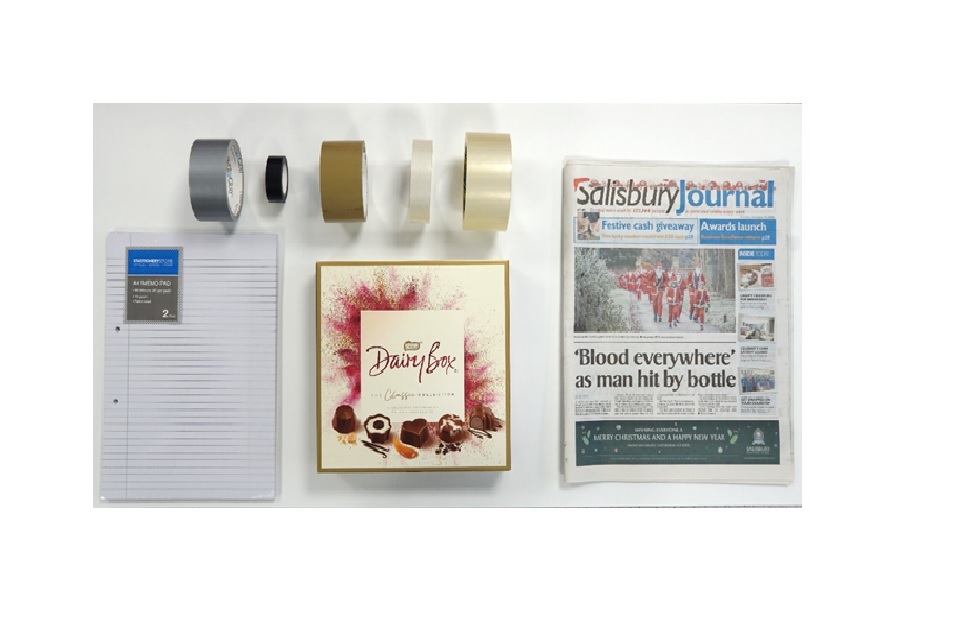Solvent-based adhesive tape removal
Published 31 January 2024
Solvent-based adhesive tape removal is listed as a Category B process in the Fingermark Visualisation Manual (FVM). This is because it could be useful where adhesive surfaces cannot be easily separated using Category A methods (such as, pulling and prising). It is known that some solvents can soften the adhesive if used carefully, but it is not fully understood if the process is detrimental to subsequent fingermark recovery. To investigate this Dstl carried out a planted fingermark study to assess the impact of 4 solvents:
- Un-du® Volatile Organic Compound (VOC) Compliant
- HFE 7100
- Heptane
- Ethanol
Experiments
Experiment 1: determine the solvents’ ability to separate substrates
Combinations of porous or semi-porous and adhesive substrates (figure 1) were adhered together to create 60 samples. They were then separated by carefully applying the solvent.
HFE 7100 was poor at enabling the separation of the samples, but the other 3 solvents were successful with minimal obvious damage.

Figure 1: Image of the substrates used in the study. Five adhesive tapes (T1-T5): duct tape; electrical tape; thin brown packaging tape; office tape; clear adhesive tape. Three porous/semi-porous items (P1-P3): Paper – notebook style; Cardboard – laminated (confectionery box); Newspaper.
Experiment 2: determine the effect of the solvents on fingermark visualisation
780 fingermarks were collected on all 13 substrates (including the adhesive and non-adhesive side of the tapes) and then the marks were halved. One half of the split samples were immersed in a solvent, left to dry and then treated with a fingermark visualisation process. The other half were treated with the fingermark visualisation process only, creating a ‘control’ sample.
Marks were graded using the 0-4 scheme. Overall, the most grade 3 or 4 fingermarks were visualised following the use of HFE 7100 or Un-du® VOC.
The use of Heptane visualised slightly fewer identifiable fingermarks. There was a noticeable drop in the number of grade 3 or 4 marks visualised following the use of Ethanol.
Due to the poor performance of HFE 7100 in experiment 1 and Ethanol in experiment 2, these solvents were discounted.
Out of the 13 substrates that were assessed, Un-du® VOC visualised more identifiable marks on 9 and Heptane performed better on the remaining 4 (P1, P2, T3 and T4).
No ridge detail was visualised on the adhesive side of the duct tape (T1) following processing with Heptane. The solvent appeared to have caused significant softening of the adhesive layer, resulting in dissolving and distorting of the adhesive layer along with the planted fingermarks (figure 2).

Figure 2: Condition of the adhesive side of duct tape (T1) following immersion in Un-du® VOC (left) and Heptane (right), left side of tape solvent sample, right side of tape control sample.
What we conclude and recommend
These experiments provide insight into the effects on subsequent fingermark visualisation following the use of 4 different solvents used for adhesive tape removal.
We found fingermark visualisation following the use of Heptane and Un-du® VOC to be similar. Un-du® VOC was the least detrimental to fingermarks out of these 2 solvents.
The samples in experiment 2 were immersed in the solvent, to give data for the worst case scenario. Immersion does have a destructive effect on specific substrates, and provides further justification for the recommendation within the Fingermark Visualisation Manual (FVM) to use minimal solvent. Un-du® VOC only contains 16% Heptane so it is likely that the damage caused by the solvent will be less due to its reduced presence in the formulation.
We do not recommend HFE 7100 due to the poor ability to effectively remove tape and per- and poly fluoroalkyl substance (PFAS) restrictions may prevent its use long-term. We also do not recommend Ethanol for adhesive tape removal due to the detrimental effect on fingermarks.
The results from this study suggest that during casework examinations involving adhesive tape removal, if the pull and prise method is unsuccessful, solvent-based tape removal may be used.
We aim to publish this study in full in a journal publication.

